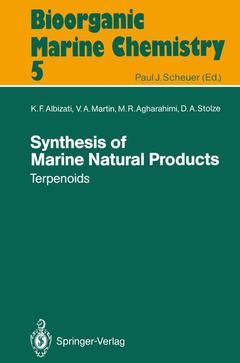Description
Synthesis of Marine Natural Products 1, Softcover reprint of the original 1st ed. 1992
Terpenoids
Coll. Bioorganic Marine Chemistry, Vol. 5
Authors: Albizati K.F., Martin V.A., Agharahimi M.R., Stolze D.A.
Language: French
Subjects for Synthesis of Marine Natural Products 1:
Keywords
Ether; Phenol; Terpene; amino acid; natural product; structure; synthesis
Approximative price 105.49 €
In Print (Delivery period: 15 days).
Add to cart
Publication date: 01-2012
280 p. · 15.5x23.5 cm · Paperback
280 p. · 15.5x23.5 cm · Paperback
Description
/li>Contents
/li>
Volumes five and six of Bioorganic Marine Chemistry differ from their predecessors in two respects - they deal exclusively with labor atory synthesis of marine natural products and they represent the effort of a single author and his associates. The rationale for these departures is readily perceived. For several decades organic synthesis has without doubt been the most spectacular branch of organic chemistry. While the late R.B. Woodward's dictum - organic compounds can undergo only four basic reactions: they can gain electrons; they can lose electrons; they can be transformed with acid or with base - is still true, the wealth and variety of available reagents which will accomplish chemical transformations has reached staggering proportions. Little wonder then, that synthetic methodology has achieved a high degree of predictability and total synthesis of natural products has been successfully directed toward ever more challenging targets. As for the second point, that of single authorship, multiple authorship would invariably have led to gaps and overlaps, thus making it difficult to assemble and assess recent research in a systematic and comprehens ive fashion.
1 Introduction.- 2 Terpenoids.- 2.1 Monoterpenoids.- 2.1.1 From Chondrococcus (Desmia) and Ochtodes sp.- 2.1.2 From Plocamium sp.- 2.1.2.1 Costatolide and Costatone.- 2.1.2.2 epi-Plocamene-D and an Unnamed Metabolite.- 2.1.3 Prenylated Phenols.- 2.1.3.1 Amaroucium Metabolite.- 2.1.3.2 Hydrallmanol A.- 2.2 Sesquiterpenoids.- 2.2.1 Lauranes.- 2.2.1.1 Laurene.- 2.2.1.2 Aplysin, Debromoaplysin and Filiformin.- 2.2.1.3 Laurinterol and Allolaurinterol.- 2.2.2 Chamigranes and Related Spirocyclics.- 2.2.2.1 10-Bromo-?-Chamigrene.- 2.2.2.2 10-Bromo-?-Chamigrene.- 2.2.2.3 Various Laurencia Metabolites.- 2.2.2.4 Spirolaurenone.- 2.2.3 Furanosesquiterpenoids.- 2.2.3.1 Pleraplysillin-1.- 2.2.3.2 Euryfuran.- 2.2.3.3 Furoventalene.- 2.2.3.4 Pallescensin A.- 2.2.3.5 Pallescensin-1.- 2.2.3.6 Pallescensins-2, F, and G.- 2.2.3.7 Dihydropallescensin-2 (Penlanpallescensin).- 2.2.3.8 Pallescensin E.- 2.2.3.9 Furodysin and Furodysinin.- 2.2.3.10 Nakafurans-8 and -9.- 2.2.3.11 Spiniferin-1.- 2.2.4 Bicyclo[4.3.0] Ring Systems.- 2.2.4.1 Brasilenol.- 2.2.4.2 Oppositol.- 2.2.4.3 Pacifigorgiol.- 2.2.5 Bicyclo[4.4.0] Ring Systems.- 2.2.5.1 Polygodial.- 2.2.5.2 Zonarene.- 2.2.5.3 Cycloeudesmol.- 2.2.5.4 Lemnal-5a-en-2-one.- 2.2.5.5 Lemnalol.- 2.2.5.6 1,4-Epoxycadinane.- 2.2.5.7 3?-Bromo-8-Epicaparrapi Oxide.- 2.2.5.8 ?-Gorgonene.- 2.2.5.9 Albicanol and Albicanyl Acetate.- 2.2.5.10 ?-Dictyopterol.- 2.2.6 Hydroazulenes.- 2.2.6.1 Africanol.- 2.2.7 Cyclooctanoids.- 2.2.7.1 Precapnelladiene.- 2.2.7.2 Poitediol.- 2.2.7.3 Dactylol.- 2.2.8 Triquinanes.- 2.2.8.1 ?9,12-Capnellene.- 2.2.8.2 ?8,9-Capnellene and ?9,12-Capnellenes.- 2.2.8.3 Subergorgic Acid.- 2.2.9 Sinularenes.- 2.2.9.1 Sinularene.- 2.2.9.2 12-Acetoxy sinularene.- 2.2.10 Caespitanes.- 2.2.10.1 Desoxyisocaespitol and Isocaespitol.- 2.2.10.2 Obtusenol.- 2.2.11 Isonitriles and Related Metabolites.- 2.2.11.1 Axisonitriles-1, -3, -4 and Axamide.- 2.2.11.2 9- and 2-Isocyanopupukeananes.- 2.2.12 Prenylated Hydroquinones and Derivatives.- 2.2.12.1 Avarol.- 2.2.12.2 Zonarol and Isozonarol.- 2.2.12.3 Puupehenone.- 2.2.12.4 Halenaquinone and Halenaquinol..- 2.2.13 Miscellaneous Sesquiterpenoids.- 2.2.13.1 Upial.- 2.2.13.2 Dactyloxenes-B and -C.- 2.2.13.3 3-Debromoperforatone, Perforenone, and an Unnamed Laurencia Metabolite.- 2.2.13.4 Aplysistatin.- 2.2.13.5 Cavernosine.- 2.3 Diterpenoids.- 2.3.1 Dolastanes.- 2.3.1.1 Dolasta-l(15), 7,9-Trien-14-ol.- 2.3.1.2 Amijitrienol.- 2.3.1.3 Isoamijiol.- 2.3.2 Adocianes and Amphilectanes.- 2.3.2.1 Hymeniacidon amphilecta Bis-isonitrile.- 2.3.2.2 7,20-Diisocyanoadociane.- 2.3.3 Spatanes.- 2.3.3.1 Stoechospermol.- 2.3.3.2 Spatol.- 2.3.4 Pseudopteranes.- 2.3.4.1 Pseudopterosin A, E.- 2.3.5 Aplysin-20 and Derivatives.- 2.3.6 Agelas Diterpenoids.- 2.3.6.1 Ageline A.- 2.3.6.2 Agelasidine C.- 2.3.6.3 Agelasidine A.- 2.3.6.4 Agelasine B.- 2.3.7 Prenylated Phenols and Derivatives.- 2.3.7.1 Taondiol Methyl Ether.- 2.3.7.2 Bifurcarenone.- 2.3.8 Miscellaneous Diterpenoids.- 2.3.8.1 Dictyolene, Pachydictyol A, and Obscuronatin.- 2.3.8.2 Petiodial and Udoteatrial.- 2.3.8.3 Reiswigin A.- 2.3.8.4 Mayolide A.- 2.3.8.5 Ambliols A and B.- 2.3.8.6 Taonianone.- 2.3.8.7 Prepinnaterpene.- 2.3.8.8 Sanadaol.- 2.3.8.9 Dictymal.- 2.4 Sesterterpenoids.- 2.4.1 Manoalide and Analogs.- 2.4.2 Miscellaneous Sesterterpenoids.- 2.4.2.1 Ircinianin.- 2.4.2.2 Dysideapalaunic Acid.- 2.4.2.3 Palauolide.- 2.5 Triterpenoids.- 2.5.1 Mokupalide.- 2.5.2 Squalene-10,11 -Oxide.- 2.5.3 Teurilene.- 2.5.4 Haloethers.- 2.5.4.1 Thyrsiferol and Venustatriol.- 2.6 Miscellaneous Terpenoids.- 2.6.1 Aplidiasphingosine.- 2.6.2 Prorocentrum Metabolite.- 2.6.3 Sigmosceptrella Metabolite.- References.
© 2024 LAVOISIER S.A.S.




